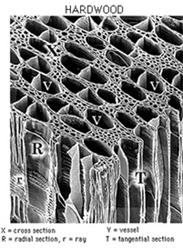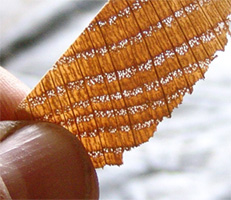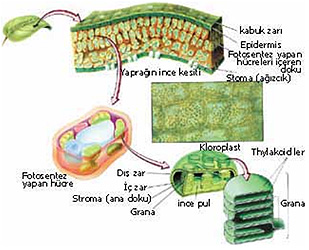Have you thought about the fire that you light? Is it you who make the trees that fuel it grow or are We the Grower? We have made it to be a reminder and a comfort for travellers in the wild. So glorify the name of your Lord, the Magnificent! (Surat al-Waqi ‘a, 71-74)
One of the chemical substances mainly responsible for the structure of wood is “lignocellulose.” This substance is a compound of the materials known as “lignin” and “cellulose” that give wood its hardness. In terms of chemicalstructure, wood is made up of 50% cellulose, 25% hemicelluloses and 25% lignin.1 An analysis of these substances’ chemical formulae reveals three vital elements: hydrogen, oxygen and carbon.
Hydrogen, oxygen and carbon are the building blocks of millions of substances in nature. But as a miracle from Allah, these three also combine to give rise to the substance “lignocellulose” found in plants. Although scientists know that they contain these substances they are unable to reproduce this special material in plants. Although these elements found in large amounts in nature can easily be obtained, scientists have been unable to obtain a single piece of wood by artificial means, despite having countless examples before them. Yet all the trees we see around us have been ceaselessly producing this compound for millions of years by combining oxygen, carbon, water and sunlight.
One of the compounds in lignocellulose is water, expressed by the formula H2O. The fact that wood is one of the most flammable materials despite containing a large amount of water is a most special state of affairs. The above verse is very wise in noting that wood cannot be made by human beings, by fire. Thanks to these compounds and the water it contains, wood is one of the most important fuels of fire.
Trees are an important sphere of scientific research, and inspire scientists, who are still struggling to grasp all the details in their creation, in a number of areas. The complex structures of the cells that constitute trees have still not been fully unraveled, despite advances in technology and intensive research. The Forestry Commission of Great Britain, one of the world’s leading forestry research institutions, says the following under the heading "Lack of Information on the Chemistry and Structure of Wood Fibres":
Despite the knowledge resulting from earlier and ongoing research, there still exists a lack of information on the chemistry and structure of wood fibres. Large variations can be found within a single tree, from the pith to the bark and from the base to the top of a tree. Often the chemistry and structure of a wood cell are extremely heterogeneous and difficult to investigate with conventional techniques. 2
A paper in the scientific journal Plant Physiology titled "Our Understanding of How Wood Develops is not Complete" describes the limited knowledge of the subject that scientists possess:
Considering the important role that wood is foreseen to play in the near future, it is surprising to see that our understanding of how wood develops is far from complete. With a few exceptions, very little is known about the cellular, molecular, and developmental processes that underlie wood formation. Xylogenesis represents an example of cell differentiation in an exceptionally complex form. This process is controlled by a wide variety of factors both exogenous (photoperiod and temperature) and endogenous (phytohormones) and by interaction between them. It is driven by the coordinated expression of numerous structural genes (some of known function) involved in cell origination, differentiation, programmed cell death, and heartwood (HW) formation and by virtually unknown regulatory genes orches trating this ordered developmental sequence. The presence of gene families and the extreme plasticity of the metabolism involved (as exemplified by the unusual behavior of plants with transformed cell walls; for review, see Fagard et al., 2000) add a further complexity to our understanding of the process of wood formation. 3
The extraordinary creation in wood is emphasized thus in another scientific journal, Annals of Botany:
Wood formation is a highly complicated process involving an unbelievable variety of metabolic steps in the roots, stem and crown of shrubs and trees. At the centre of these processes is cambial activity which results in the release of young woody cells that undergo maturation until autolysis of the protoplast, indicating the final developmental stage. Later on, in various tree species, woody cells become further modified by an additional process called heartwood formation. The properties of wood that make it an appropriate raw material for many purposes are largely determined by the specific architecture of the cell walls. Difficulties in investigating these many developmental stages appear when routine techniques, which work well for soft plant tissues, are applied. Therefore, in most cases, these techniques need modification or the use of completely revised protocols to yield good results for woody tissues. 4
These details in the creation of wood remind us, as set out in Surat al-Waqi ‘a, that wood cannot be made by human beings. Just a few of the inimitable features of wood, which cannot be produced artificially, are as follows:
| Wood, a Resistant Material The hard and resistant nature of wood is the result of the cellulose fibers it contains. Because cellulose is hard and insoluble in water. It is this property of cellulose that makes the use of wood in construction so advantageous. Cellulose, described as a “contractible and incomparable substance,” has for centuries been used a great deal more than other materials in keeping wooden buildings standing, other buildings, bridges and many other structures. Wood consists of parallel columns made up of convex cells laid end to end. These are surrounded by cellulose fibers in spiral form. In addition, these cells are contained in “lignin,” a substance made from a complex, polymer structure resin. These spirally enclosed layers make up 80% of the thickness of the cell wall and are the part bearing the main load. When a wood cell collapses internally it absorbs the shock of a blow by detatching itself from the surrounding cells. Even when such collapses causes a crack along the length of the fiber, the wood remains unharmed. That is why wood is strong enough to bear specific loads even if it is broken. In terms of absorbing the energy of low-speed blows and reducing the damage therefrom, wood is a most important material. The Second World War plane known as the “Mosquito” was made by compressing wood between strips of fiber board, making it the most damage-resistant plane of its time. The hardness and resistant nature of wood make it a very reliable material. Because wood breaks or cracks slowly enough to be visible from the outside, and that gives people enough time to take the necessary precautions . 5 A material based on the structure of wood can be up to 50 times more resistant than other synthetic materials in use today. 6 This unique structure of wood is today used in materials developed to protect against the impact of high speed and destructive fragments such as bombs and bullets. But scientists have never been able to replicate a piece of wood with all its many attributes. Every detail in the creation of wood, - the thickness of the internal layers, their level of compression, the number of vessels, their layout and the materials inside it, have been specialy created to result in that resistance. |
| The Hydraulic System That Raises Water Many Meters against the Force of Gravity The dead part of wood, the “xylem,” contains hollow channels. These, also known as “wood vessels,” consist of inanimate cells that gradually lose their nuclei and cytoplasms piled one on top of the other. Long, thin wood vessels form when the membranes between the cells dissolve and disappear. Roots spreading out beneath the soil carry the water and minerals the plant needs upward through these tissues and transmit them as far as the leaves. The way the roots absorb the water in the ground is literally reminiscent of the test bore technique. The roots have no engines to initiate the water absorption process. Neither do they have any technical equipment with which to pump water and minerals for distances of up to several meters. But the roots absorb the water in the depths of the soil by spreading over a very wide area. This lifting process that the plant performs so flawlessly is in fact an exceedingly complex one. Yet this system has still not yet been fully understood, even in these days of high technology and space travel. The present of a “hydraulic system: in plants was determined some two centuries ago. But we still do not know how this action in defiance of the force of gravity takes place. The superior technology squeezed into such a confined space is just one of the examples demonstrating the incomparable knowledge of our Lord the creator of the system. Like everything in the universe, Almighty Allah created the transportation system in trees.
|
| Roots Capable of Selecting Minerals from the Soil: Plants draw all the mineral nutrients they need, such as potassium, phosphorus, calcium, magnesium and sulfur, from the soil. Since the substances are not found seprately in the soil, they absorb them as ions (positive/negatively charged atoms). Of all the many inorganic ions in dissolved state in the soil, plants absorb only the 14 they need. The iron concentration inside plant cells is 1,000 times greater than that in the soil outside.8 Under normal condition, an exchange of matter from a high density region to a lower density one will take place. But exactly the opposite happens in plant roots, and the ions in the soil are easily able to pass into the root cells.9 Because of this state of affairs that operates contrary to the pressure system, the plant uses a high level of energy in the pumping process. In addition, in the plant roots’ taking up ions from the soil, there needs to be an identification system that attracts only the wanted ions and repels the unwanted ones. This shows that the ion pumps in the root cells are no ordinary pumps, but possess the ability to select between ions. Bearing in mind that the cell in the plant roots are made up of atoms devoid of any intelligence or consciousness, one can better see what an extraordinary process ion selection truly is. |
| Photosynthesis: The Superior Technology in a Miniature Factory It is not only the wood and root parts of trees that cannot be obtained by artificial means, but also the leaves. Most important of the features that make leaves inimitable is their ability to make photosynthesis. Photosynthesis, one of the systems that scientists still do not fully understand, may be summarized as plants manufacturing their own nutrients. Thanks to the structure in plant cells that makes them able to make direct use of solar energy, they store solar energy, at the end of various complex processes, in the form of energy that can be used by human beings and animals. In addition, the photosynthetic energy stored in trees is also given off during burning. For example, the energy emitted by wood burned to heat a house is actually energy from the Sun stored during the formation of wood.10 The photosynthesis system, which operates like a miniature factory, takes place in an organelle known as the “chloroplast” inside the plant cell that gives the plant its green color. Chloroplasts are just one-thousandth of a millimeter in size, for which reason they can only be seen under the microscope. When solar energy falls on the leaf they transmit it to the layers inside it. Chlorophyls inside the choloplasts in the leaf cells convert this light energy into chemical energy. The plant obtaining this chemical energy immediately uses it in obtaining nutrients. It took scientists until the mid-20th century to obtain this information summarized in just a few lines here. Pages of chain reactions are written to describe the whole process of photosynthesis. But some links in the chain are still unknown. Yet plants have been performing these processes uninterruptedly for hundreds of millions of years, thus providing the Earth with food and oxygen.
|
The fact that not a single cell constituting wood can be made by artificial means, and human beings’ helplessness in the face of dead wood cells, shows the presece of a sublime Creator. The properties of wood, about which many volumes could be written, their countless aspects that so inspire scientists, all reveal the sublime knowledge and intellect behind the creation of wood. This intelligence and knowledge manifested in wood belongs to Almighty Allah, the Creator and sole Lord of all things.
___________________________________________________
1 http://www.forestpathology.org/wood.html; Wood Chemistry and Anatomy, 2005.
2 http://www.forestresearch.gov.uk/fr/INFD-6FMCUS; The Research Agency of the Forestry Commission, 2007.
3 Christophe Plomion, Gregoire Leprovost, Alexia Stokes, "Wood Formation in Trees", Plant Physiology, December 2001, Vol. 127, pp. 1513–1523.
4 Uwe Schmitt, "Chaffey, N.J. ed. Wood formation in trees—cell and molecular biology techniques", Annals of Botany, 2002, Vol. 90, no. 4, pp. 545-546.
5 Julian Vincent, "Tricks of Nature", New Scientist, 17 August 1996, Vol. 151, no. 2043, p. 39.
6 Julian Vincent, "Tricks of Nature", New Scientist, 17 August 1996, Vol. 151, no. 2043, p. 40.
7 http://www.smddrums.com/woodcell.htm
8 Malcolm Wilkins, Plantwatching, Facts on File Publications, New York, 1988, p. 119.
9 William K. Purves, Gordon H. Orions, H. Craig Heller, Life, The Science of Biology, 4th edition, W.H. Freeman and Company, p. 724.
10 http://www.montana.edu/wwwpb/pubs/mt8405.html; Michael Vogel, "Heating with Wood: Principles of Combustion", 2003.





